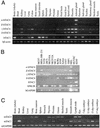Characterization of the endokinins: human tachykinins with cardiovascular activity
- PMID: 12716968
- PMCID: PMC156357
- DOI: 10.1073/pnas.0931458100
Characterization of the endokinins: human tachykinins with cardiovascular activity
Abstract
We report four human tachykinins, endokinins A, B, C, and D (EKA-D), encoded from a single tachykinin precursor 4 gene that generates four mRNAs (alpha, beta, gamma, and delta). Tachykinin 4 gene expression was detected primarily in adrenal gland and in the placenta, where, like neurokinin B, significant amounts of EKB-like immunoreactivity were detected. EKA/B 10-mers displayed equivalent affinity for the three tachykinin receptors as substance P (SP), whereas a 32-mer N-terminal extended form of EKB was significantly more potent than EKA/B or SP. EKC/D, which possess a previously uncharacterized tachykinin motif, FQGLL-NH(2), displayed low potency. EKA/B displayed identical hemodynamic effects to SP in rats, causing short-lived falls in mean arterial blood pressure associated with tachycardia, mesenteric vasoconstriction, and marked hindquarter vasodilatation. Thus, EKA/B could be the endocrineparacrine agonists at peripheral SP receptors and there may be as yet an unidentified receptor(s) for EKC/D.
Figures





Similar articles
-
Hemokinins and endokinins.Cell Mol Life Sci. 2004 Jul;61(13):1652-63. doi: 10.1007/s00018-004-4035-x. Cell Mol Life Sci. 2004. PMID: 15224188 Free PMC article. Review.
-
Effects of endokinin A/B, endokinin C/D, and endomorphin-1 on the regulation of mean arterial blood pressure in rats.Peptides. 2011 Dec;32(12):2428-35. doi: 10.1016/j.peptides.2011.10.017. Epub 2011 Oct 20. Peptides. 2011. PMID: 22037058
-
Effects of Endokinin A/B and Endokinin C/D on the modulation of pain in mice.Peptides. 2010 Jan;31(1):94-100. doi: 10.1016/j.peptides.2009.10.013. Epub 2009 Oct 23. Peptides. 2010. PMID: 19854230
-
Intrathecal administration of the common carboxyl-terminal decapeptide in endokinin A and endokinin B evokes scratching behavior and thermal hyperalgesia in the rat.Neurosci Lett. 2006 Dec 27;410(3):193-7. doi: 10.1016/j.neulet.2006.09.024. Epub 2006 Nov 13. Neurosci Lett. 2006. PMID: 17101218
-
Characterization of the gene structures, precursor processing and pharmacology of the endokinin peptides.Vascul Pharmacol. 2006 Oct;45(4):200-8. doi: 10.1016/j.vph.2005.08.028. Epub 2006 Jul 6. Vascul Pharmacol. 2006. PMID: 16931167 Review.
Cited by
-
A comparison of the effects of amide and acid groups at the C-terminus on the collision-induced dissociation of deprotonated peptides.J Am Soc Mass Spectrom. 2012 Sep;23(9):1544-57. doi: 10.1007/s13361-012-0431-x. Epub 2012 Jul 26. J Am Soc Mass Spectrom. 2012. PMID: 22833234
-
Role of neurokinin-1 receptor in the initiation and maintenance of skin chronic inflammatory diseases.Immunol Res. 2011 Aug;50(2-3):195-201. doi: 10.1007/s12026-011-8219-9. Immunol Res. 2011. PMID: 21717076
-
Mouse Hemokinin-1 Decapeptide Subjected to a Brain-specific Post-translational Modification.In Vivo. 2017 Sep-Oct;31(5):991-998. doi: 10.21873/invivo.11159. In Vivo. 2017. PMID: 28882971 Free PMC article.
-
Neurokinin-1 receptor directly mediates glioma cell migration by up-regulation of matrix metalloproteinase-2 (MMP-2) and membrane type 1-matrix metalloproteinase (MT1-MMP).J Biol Chem. 2013 Jan 4;288(1):306-18. doi: 10.1074/jbc.M112.389783. Epub 2012 Nov 19. J Biol Chem. 2013. PMID: 23166329 Free PMC article.
-
Future innovations in anti-platelet therapies.Br J Pharmacol. 2008 Jul;154(5):918-39. doi: 10.1038/bjp.2008.151. Epub 2008 Apr 21. Br J Pharmacol. 2008. PMID: 18587441 Free PMC article. Review.
References
-
- Severini C, Improta G, Falconieri-Erspamer G, Salvadori S, Erspamer V. Pharmacol Rev. 2002;54:285–322. - PubMed
-
- Nawa H, Hirose T, Takashima H, Inayama S, Nakanishi S. Nature. 1983;306:32–36. - PubMed
-
- Nawa H, Kotani H, Nakanishi S. Nature. 1984;312:729–734. - PubMed
-
- Kawaguchi Y, Hoshimaru M, Nawa H, Nakanishi S. Biochem Biophys Res Commun. 1986;139:1040–1060. - PubMed
-
- Tatemoto K, Lundberg J M, Jornvall H, Mutt V. Biochem Biophys Res Commun. 1985;128:947–953. - PubMed
Publication types
MeSH terms
Substances
Associated data
- Actions
- Actions
- Actions
- Actions
- Actions
LinkOut - more resources
Full Text Sources
Other Literature Sources
Molecular Biology Databases
Miscellaneous

